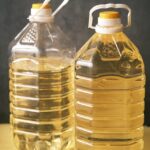
What is vegetable oil? Most vegetable oil is oil extracted from the seeds of plants, and sometimes from the plants themselves.
Vegetable oil is an accurate name for the product in that the oil comes from plants, but they are not all technically vegetables. The name was chosen partly because the word “vegetable” conjures up images of healthy food and makes us think that the oil is good for us. As with anything, some vegetable oils are healthy and are actually made from vegetables and some vegetable oils are less healthy and have never even seen a vegetable. The most common vegetable oils are palm oil, soybean oil, sunflower oil, and rapeseed oil, which is called canola oil. Interestingly, canola oil is made from rapeseed, but the marketing board didn’t think the word “rape” would sell very well, so they changed the name to canola, which comes from Canada Oil Low Acid. The word “rape” in rapeseed is actually the Latin word for turnip (rapum).
Vegetable oils are the most consumed food in the world after rice and wheat and they make up 20% of our daily calorie intake. They are very versatile oils, and they are not only used for frying but also for coloring, flavoring, and making sure mixtures stick together. The biggest reason why palm oil, soybean oil, sunflower oil, and rapeseed oil are the most common oils is that they are extremely cheap. There are other vegetable oils like avocado oil and olive oil that are far more expensive, and you don’t usually see them in ultra-processed foods.
So, how do you get vegetable oil out of vegetables? Let’s look at soybean oil, which is the most common vegetable oil you will find in your kitchen. You can also find soybean oil in a huge number of things that we eat. It’s in dressings, margarine, breads, mayonnaise, snacks, and a pile of other things. The first step in making soybean oil is to obviously get the soybeans. Soybeans are grown in many countries around the world, and they are known as an industrial crop because of the scale of their production. Over 350 million tons of soybeans are produced every year and Brazil is the world’s biggest producer. A lot of the deforestation in the Brazilian rainforest is to make fields to grow soybeans, which is seen as a far more profitable crop. Soybeans are very healthy, a great source of protein and oils, and they can fix damaged soils. They were planted in the dustbowls of America during the 1930s and regenerated the soil. The problem is not the soybean, the problem is the enormous quantities they are farmed in.
Once the soybeans have been harvested, they are washed to get rid of stones, dust, and other impurities. Getting out all of the bits keeps the oil purer, but it also protects the machinery. The next step is to get the shell off the soybean. The soybean is a seed and seeds have an outer shell to protect the embryonic plant and its food stores inside. This shell has to be removed because the oil company wants to get at the plant and the food stores. The inside of the seed is made up of about 20% oil, 36% protein, 30% carbohydrates, and the rest is water. The shell is removed with a machine that cracks and breaks it off. Then the inside part of the seed is flattened to increase its surface area. These flattened seeds are then coked to break up the oil holding cells, before they are heated again to expand them. Then they go to the extraction plant where the oil is brought out of them using a solvent. Olive oils are pressed out of the olives, but soybean oil is removed with a solvent that dissolves the oil from the soybeans and it is washed out. Using a solvent is far more economical than a press because it removes more of the oil. The solvent has to be removed and that is done by heating the oil. Then the oil is distilled. It’s still not ready, though. The oil has to be refined. Any sticky bits are removed. The coloring is removed by bleaching and then the remaining odors are removed. The oil is finished and ready to be sold.
All of the other vegetable oils are produced in pretty much the same way. Consumption of all of these oils has almost doubled year on year since they were first introduced and most of the time, we don’t know that we are eating them. And this is what I learned today.
Sources
https://www.zeroacre.com/blog/the-history-of-vegetable-oils
https://en.wikipedia.org/wiki/Vegetable_oil
https://en.wikipedia.org/wiki/Soybean_oil
https://www.bestoilmillplant.com/soya-oil-solvent-extraction-process-guide.html
https://www.nandtengitech.com/blog/soybean-oil-extraction-process
https://www.history.com/news/soybean-china-american-crop-tariffs
Photo by Towfiqu barbhuiya: https://www.pexels.com/photo/clear-plastic-bottles-with-yellow-liquid-12284682/

